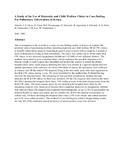| dc.contributor.author | Aluoch, J A | |
| dc.contributor.author | Oyoo, D | |
| dc.contributor.author | Swai, B O | |
| dc.contributor.author | Kwamanga, D | |
| dc.contributor.author | Edwards, R | |
| dc.contributor.author | Agwanda, I | |
| dc.contributor.author | Edwards, E A | |
| dc.contributor.author | Stott, H | |
| dc.contributor.author | Darbyshire, J H | |
| dc.contributor.author | Fox, W | |
| dc.contributor.author | Sutherland, I | |
| dc.date.accessioned | 2013-06-10T13:00:18Z | |
| dc.date.available | 2013-06-10T13:00:18Z | |
| dc.date.issued | 1987 | |
| dc.identifier.citation | Tubercle. 1987 Jun;68(2):93-103. | en |
| dc.identifier.uri | http://www.ncbi.nlm.nih.gov/pubmed/3499017 | |
| dc.identifier.uri | http://erepository.uonbi.ac.ke:8080/xmlui/handle/123456789/30868 | |
| dc.description.abstract | This investigation is the seventh in a series of case-finding studies in Kenya. It explores the potential value of questioning mothers attending maternity and child welfare (M & CW) clinics to identify tuberculosis suspects (individuals aged 6 years or more with a cough for 1 month or more or hemoptysis) living in their households. The study was carried out in all the eight M & CW clinics in two divisions (populations 86,000 and 112,000) of two different districts. The mothers were asked to give a standard letter, which explained the possible importance of a chronic cough, to each suspect they identified and invited the suspect to attend the district hospital chest clinic. Each suspect attending the clinic was entered in a special register and two sputum specimens were collected. For those who failed to attend, the specimens were collected at a home visit. Of the total of 342 suspects living in the two study areas who were registered at the M & CW clinics during 1 year, 261 were identified by the mothers but 19 denied having received the standard letter. The remaining 81 had not been identified by mothers but had attended the M & CW clinics on their own initiative. Of the 242 suspects who received the letter, 89 (39%) attended the hospital chest clinic, 74% within a week of the letter being issued from the M & CW clinic. The main reasons given for not attending the hospital chest clinic by the remaining suspects were financial or because their cough had improved or disappeared. Sputum was collected from 238 suspects and examined bacteriologically: in six (2.5%) it was positive for tubercle bacilli on smear and culture and in a further two (0.8%) the sputum was positive on culture only. Of those attending the hospital chest clinic 2.9% were smear- and culture-positive and 4.7% were culture positive. This method of case-finding has yielded disappointing results, for only 4% of the estimated annual incidence of smear-positive cases was detected. | en |
| dc.language.iso | en | en |
| dc.publisher | University of Nairobi | en |
| dc.title | A Study Of The Use Of Maternity And Child Welfare Clinics In Case-finding For Pulmonary Tuberculosis In Kenya. | en |
| dc.type | Article | en |
| local.publisher | Respiratory Diseases Research Centre, Nairobi, Kenya. | en |

